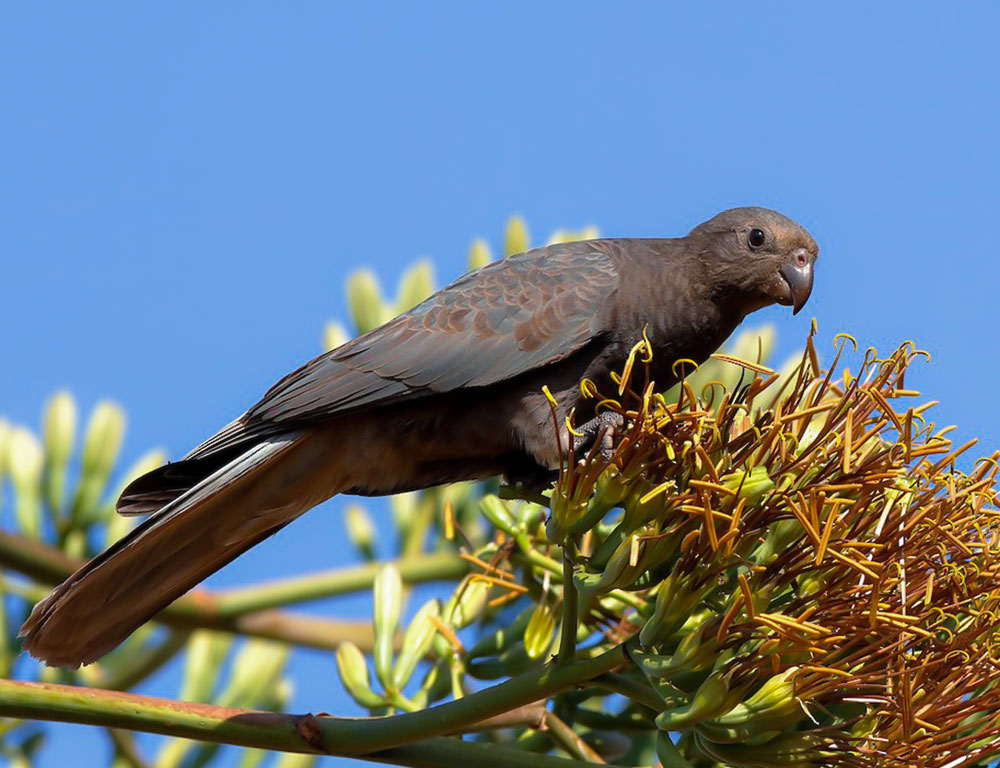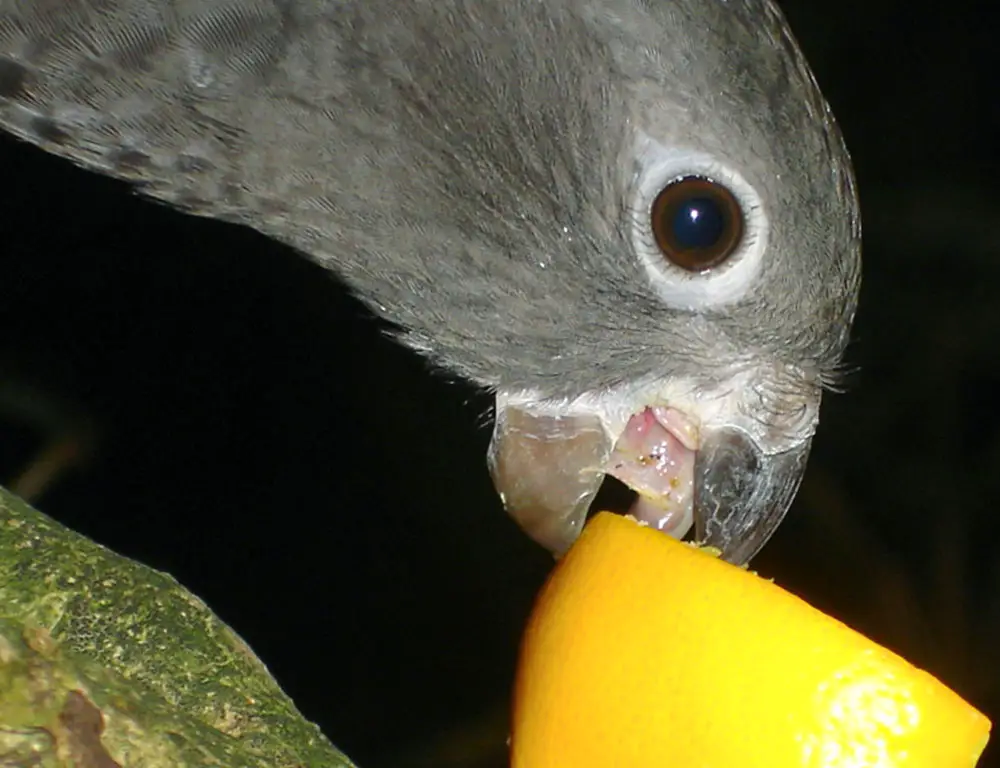The Lesser Vasa Parrot, scientifically known as Coracopsis nigra, is a captivating avian species inhabiting the dense forests and woodlands of Madagascar and nearby islands in the Indian Ocean.
This medium-sized parrot, characterized by its striking plumage and distinct facial markings, holds a unique charm among bird enthusiasts and researchers alike.
With its predominantly black plumage adorned with dashes of vibrant colors and a distinct red patch on its bill, the Lesser Vasa Parrot is a sight to behold in its natural habitat.
Renowned for its intelligence and playful demeanor, this parrot species exhibits remarkable problem-solving abilities and vocalizations, making it an intriguing subject for behavioral studies.
Despite its smaller stature compared to its larger counterpart, the Greater Vasa Parrot, the Lesser Vasa Parrot’s presence in Madagascar’s ecosystem plays a crucial role in seed dispersal and forest regeneration, highlighting its ecological significance.

Physical Characteristics of the Lesser Vasa Parrot
The Lesser Vasa Parrot (Coracopsis nigra) possesses distinctive physical characteristics that set it apart from other parrot species:
Size
The Lesser Vasa Parrot is a medium-sized bird, typically measuring around 14 to 20 inches (35 to 50 centimeters) from beak to tail-tip.
Coloration
The Lesser Vasa Parrot boasts predominantly black plumage with flashes of vibrant colors, notably red on its bill. Its striking contrast and distinct facial markings contribute to its allure.
This unique coloration not only aids in camouflage within its habitat but also distinguishes it as a visually captivating species.
Feather Color Change
One of the most remarkable features of this bird is its ability to change feather color during mating season. Male Lesser Vasa Parrots transform, turning their gray plumage to chalky white during this period, while females may develop lighter patches.
Additionally, they lose all their head feathers during mating season, giving them a bald appearance, which is unique among parrot species.
Beak
The Lesser Vasa Parrot has a robust, curved beak, well-suited for cracking open nuts and seeds, which are essential components of its diet. The beak is typically grayish-black but may turn whitish during mating season, adding another layer of intrigue to its appearance.
Other Features
In addition to its plumage and beak, the Lesser Vasa Parrot has striking red eyes in adulthood, adding to its distinctive appearance. The bird’s sleek and streamlined body shape further contributes to its unique physical profile.
Habitat and Distribution of the Lesser Vasa Parrot
The habitat and distribution of the Lesser Vasa Parrot are closely tied to its native range and environmental preferences:
Native Range
The Lesser Vasa Parrot is native to Madagascar, a large island nation in the Indian Ocean off the southeastern coast of Africa. It is also found in some nearby islands, including the Comoros Islands.
Established Populations
While Madagascar remains the primary natural habitat for the Lesser Vasa Parrot, small populations have been established in other regions as well.
These include the Comoros Islands and Seychelles Islands, although the populations in these areas are relatively limited compared to Madagascar.
Preferred Habitat
Lesser Vasa Parrots exhibit adaptability in their habitat preferences. They can be found in various wooded habitats, including dry forests, deciduous forests, spiny desert-thicket habitats, and secondary growths.
They may even inhabit plantations. These birds prefer areas with plenty of cover and food sources, indicating a preference for habitats with diverse vegetation.
Behavior and Diet of the Lesser Vasa Parrot

The behavior and diet of the Lesser Vasa Parrot are indeed fascinating and highlight its unique adaptations:
Behavior
- Social Interactions: Lesser Vasa Parrots are highly social birds, forming large flocks of several hundred individuals. Within these flocks, they engage in various social behaviors such as mutual grooming and food sharing.
This communal lifestyle strengthens social bonds among flock members and contributes to their overall well-being. - Mating Rituals: During the breeding season, male Lesser Vasa Parrots undergo a distinctive change in appearance, losing their head feathers and revealing bare gray skin.
This unusual transformation sets them apart from many parrot species and plays a role in courtship displays and mate attraction. - Feeding Habits: Lesser Vasa Parrots are primarily frugivorous, mainly feeding on fruits such as figs and berries. They also consume seeds and nuts, which are essential diet components.
They may occasionally eat insects and even raid crops, particularly maize fields.
Their preference for foraging during twilight distinguishes them from many parrot species, primarily diurnal feeders.
Diet
- Main Foods: The main foods in the diet of Lesser Vasa Parrots include fruits, especially figs and berries, and seeds/nuts. These provide essential nutrients and energy for their daily activities and reproduction.
- Occasional Foods: While fruits and seeds/nuts are the primary components of their diet, Lesser Vasa Parrots may also occasionally consume insects. This behavior supplements their diet with additional protein and nutrients.
- Feeding Times: Lesser Vasa Parrots are nocturnal feeders, prefer foraging during twilight hours. This behavioral adaptation allows them to avoid competition with other diurnal bird species and take advantage of food resources during less crowded times.
Conservation Status of the Lesser Vasa Parrot
The conservation status of the Lesser Vasa Parrot (Coracopsis nigra) is currently classified as “Least Concern” on the IUCN Red List.
While this designation suggests that the species is not presently facing immediate threats to survival, it’s crucial to remain vigilant about ongoing conservation efforts to ensure its long-term viability.
Population Estimates
Population estimates for the Lesser Vasa Parrot have remained relatively stable. According to data from 1981 to 2016, the population has been estimated to range between 50,000 to 499,999 individuals.
Although these numbers indicate a healthy population, it’s essential to recognize the potential impact of threats such as habitat loss and fragmentation on future population trends.
Let’s drill down into some numbers:
| Year | Population Estimate |
|---|---|
| 1981 | 50,000-499,999 |
| 2009 | 100,000-499,999 |
| 2012 | 100,000-499,999 |
| 2016 | 100,000-499,999 |
Threats
Despite their stable population numbers and current conservation status, Lesser Vasa Parrots face significant threats, primarily due to habitat destruction and deforestation.
Human activities such as logging, agriculture, and urbanization continue to infringe upon their natural habitats, leading to the loss of nesting sites and food resources. Additionally, illegal pet trade poses a threat to wild populations.
Conservation Measures
Various conservation measures are recommended to safeguard the Lesser Vasa Parrot’s future.
These include:
- Maintaining Natural Habitats: Protecting existing forests and reforesting cleared areas can provide safe spaces for Lesser Vasa Parrots to thrive. Habitat preservation is critical for ensuring the availability of suitable nesting sites and food sources.
- Awareness and Education: Educating local communities about the importance of wildlife conservation and the ecological role of Lesser Vasa Parrots can foster a sense of stewardship and encourage responsible behavior toward protecting these birds and their habitats.
- Legal Protection: Implementing and enforcing laws and regulations that protect wildlife, including the Lesser Vasa Parrot, can help deter illegal activities such as poaching and habitat destruction. Legal frameworks should be in place to address threats posed by the illegal pet trade.
FAQs
What is the lifespan of a Lesser Vasa Parrot?
Lesser Vasa Parrots can live up to 30 years in captivity with proper care and attention.
Are Lesser Vasa Parrots noisy birds?
Compared to other parrot species, Lesser Vasa Parrots are known for their relatively quiet demeanor, making them suitable for households where noise levels are a concern.
Do Lesser Vasa Parrots require special dietary considerations?
While they primarily feed on fruits, seeds, and nuts, providing a varied diet is essential to meet their nutritional needs.
Supplementing fresh fruits, vegetables, and occasional protein sources like insects can improve their health.
Are Lesser Vasa Parrots prone to any specific health issues?
Like all parrots, Lesser Vasa Parrots may be susceptible to specific health issues, such as respiratory infections, nutritional deficiencies, and obesity.
Regular veterinary check-ups and a balanced diet can help prevent these issues.
Do Lesser Vasa Parrots require specific environmental conditions?
While adaptable, Lesser Vasa Parrots thrive in environments with plenty of enrichment opportunities, such as toys, perches, and social interaction.
Providing a spacious cage or aviary with mental and physical stimulation opportunities is essential for their well-being.
Conclusion
Studying the Lesser Vasa Parrot has illuminated its captivating nature, from its striking appearance to its intricate behaviors. This species showcases remarkable feeding habits, social dynamics within large flocks, and dedicated nesting practices.
However, amidst its wonders, threats loom, including habitat loss and the illegal pet trade. As natural stewards, we are responsible for safeguarding this incredible bird. Deepening our understanding of its complexities enriches our conservation efforts.
By protecting the Lesser Vasa Parrot and its habitat, we contribute to preserving biodiversity and ecological balance. Every creature, including the Lesser Vasa Parrot, sustains our planet’s natural harmony.